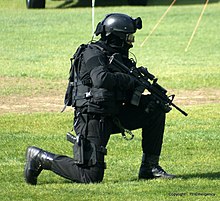Armed Offenders Squad
| Armed Offenders Squad | |
|---|---|

AOS member in 2010
|
|
| Active | August 1964 - Present |
| Country |
|
| Branch | New Zealand Police |
| Role | Law Enforcement |
| Size | 17 Squads, 320 part-time officers |
| Garrison/HQ | Wellington |
| Nickname(s) | AOS |
| Colors | Black berets |
| Engagements |
Aramoana massacre 2007 New Zealand anti-terror raids 2009 Napier shootings |
The Armed Offenders Squad (AOS) are specialist part-time units of the New Zealand Police based around the country available to respond to high risk incidents utilising specialist tactics and equipment.
The AOS was established when front-line police officers did not carry firearms. In contrast, today officers continue to not routinely carry sidearms, but have ready access to firearms if required, including high-powered rifles, and receive firearms training. A new expanding role for the AOS is assisting with planned operations.
In 1963, the unarmed New Zealand Police lost four police officers killed by lone gunmen in two separate firearms incidents at Waitakere, Auckland in January 1963 and at Lower Hutt, Wellington in February 1963. The detective who investigated the Waitakere killings recommended the creation of a unit to deal with armed offenders spending time with the New South Wales Police Emergency Squad. The AOS was formally started in August 1964 trained by the New Zealand Special Air Service (NZSAS) with the philosophy of "cordon, contain and appeal".
One of the highest-profile AOS interventions is their action during the Aramoana massacre on 13–14 November 1990, which involved at least 150 police officers. Officers from the Special Tactics Group were also present at the crisis. Sergeant Stewart Guthrie, an NCO in the AOS, was killed in the massacre, although he arrived alone with only a revolver, ahead of the fully equipped team from Dunedin.
On 15 October 2007, members the AOS and the full-time Special Tactics Group conducted several raids across New Zealand in response to the uncovering of alleged paramilitary training camps deep in the Urewera mountain ranges. Roughly 300 police were involved in the raids. Four guns and roughly 230 rounds of ammunition were seized and 17 people were arrested. According to the police the raids were a culmination of more than a year of surveillance that uncovered and monitored the training camps. The warrants were executed under the Summary Proceedings Act, the Terrorism Suppression Act, and the Arms Act. Raids were conducted in Wellington, Christchurch, Taupo and Tauranga. Allegations of New Zealand Police searching a school bus also surfaced.
...
Wikipedia
